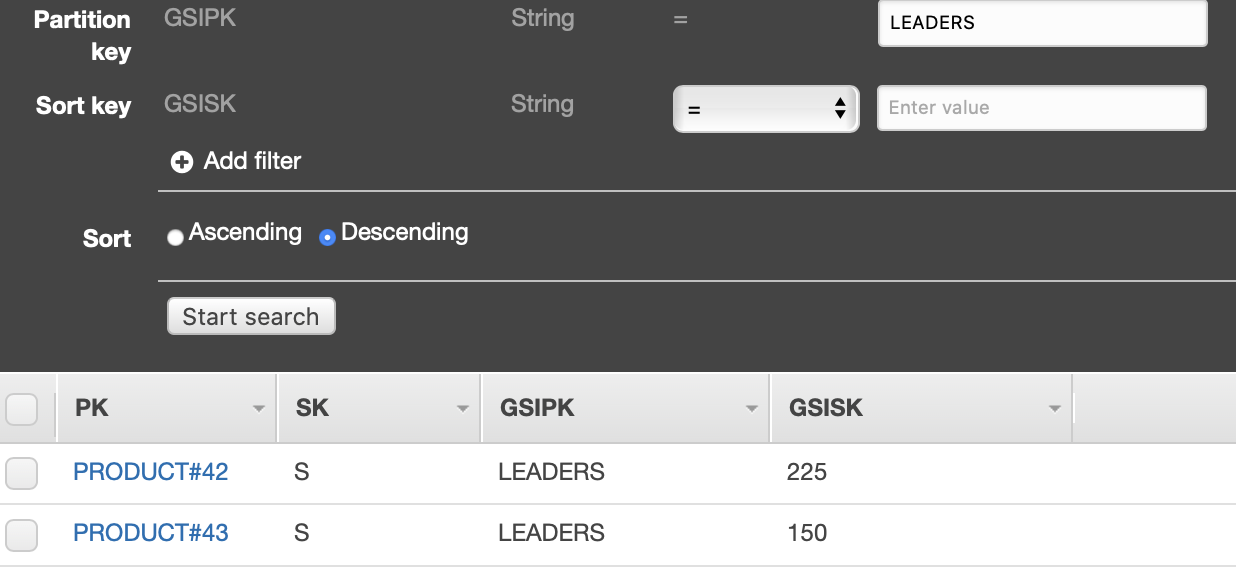This series of posts demonstrates efficient filtering and pagination with DynamoDB.
Part 1: Duplicating data with Lambda and DynamoDB streams to support filtering
Part 2: Using global secondary indexes and parallel queries to reduce storage footprint and write less code
Part 3: How to make pagination work when the output of multiple queries have been combined
Part 4: Storage and retrieval of comment statistics using index overloading and sparse indexes
In this post we will explore how to store and retrieve statistics relating to the comments a product has. We will do it without making any table changes or adding new indexes.
So far, we have built a commenting system that allows users to filter by any combination of rating (1-5) and a single language. Displaying counts for a given criteria will provide a better user experience. The statistics will also allow the query planner to make more efficient queries by skipping sub-queries when the count is zero.
New access patterns
AP7- comment count by rating for a productAP8- comment count by rating for a product, filtered by one languageAP9- grand total of comments for a productAP10- grand total of comments for a product, filtered by one languageAP11- a leaderboard of the top N products that have the most 5-rated comments
Storage
In our existing table we will create new items to store statistics alongside the comments. As the new items will represent aggregated statistics from comments relating to a PRODUCT, they are added with partition key following the format PRODUCT#<idenfitier>.
The table sort key will store a coded description of what the statistics item represents: S#<language>, with an item for each applicable language. The total counts across all languages will be stored in an additional item with sort key S. The item has count_* attributes containing a count for each applicable rating.
The below table shows two new partitions in our existing table for PRODUCT#42 and PRODUCT#43.

To support the leaderboard in AP11, under the S item, an existing GSI is overloaded. GSIPK is set to a single partition called LEADERS and GSISK is set to the number of comments with rating 5. The leader board emerges when we view the GSI. If this product does not have any 5-rated comments, the LEADERS item will not be created.

We have stored the number of 5-rated comments in the sort key, so order will be maintained. When we query this GSI, we will set ScanIndexForward to false to get the highest numbers first. The LEADERS item will only appear in this GSI.
Regional leaderboards are not in scope, but would be possible to achieve by populating GSKPK with a language suffix, for example LEADERS#en, in the subsequent items.
Queries
AP7: comment count by rating for a product
- Query on
table- PK =
PRODUCT#42 - SK =
S
- PK =
- Read all attributes
count_*
AP8: comment count by rating for a product, filtered by one language
- Query on
table- PK =
PRODUCT#42 - SK =
S#en
- PK =
- Read all attributes
count_*
AP9: grand total of comments for a product
See AP7, read attribute count_total.
AP10: grand total of comments for a product, filtered by one language
See AP8, read attribute count_total.
AP11: a leaderboard of the top N products that have the most 5-rated comments
- Query on
gsi- PK =
LEADERS - SK = (not set)
- Limit:
10(for top 10) - Scan index forward:
false
- PK =
- Read key
GSISKfor count of5rated comments - Read key
PKfor product identifier

Write path
DynamoDB Streams and a Lambda function would be used to ensure the statistics items are recalculated upon each change event.
Updating statistics in an event driven manner means it is inexpensive to get the count by simply reading the relevant items.
If this feature was being added after the system originally went live, Step Functions or EMR could be used to parallel scan the table and retroactively populate the statistics.
Alternatively, you could send the events from DynamoDB Streams to another store like Apache Druid and periodically siphon the aggregated values back into DynamoDB. This would introduce some latency and the risk of many queries being run whose answers never get looked at. Instead, your API could route certain queries to Druid and certain queries to DynamoDB, possibly combining the results into a single response.
Summary
We’ve extended our model to support storage of statistics and associated access patterns, and, best of all, we have done it without modifying the table or adding any new indexes.
All we have done is add more items and thought up some new queries. No existing queries needed to be changed.
Index overloading was used when we repurposed an existing GSI to store the leaderboard.
Sparse indexes were used to ensure the statistics items do not appear in GSIs as we have not set any GSI keys. This saves on replication costs and provides a natural filter, as statistics access patterns only query the table. The exception is the S statistics item, which does set GSIPK to LEADER and GSISK to the count of 5-rated comments. This is so it appears in GSI, in order. GSISK is used to store the creation date in the context of GSIPK: 'PRODUCT#42/...' items. It’s used for something entirely different in the context of GSIPK: 'LEADER' items.
Comments and corrections are welcome. I am working on making the diagrams more accessible.